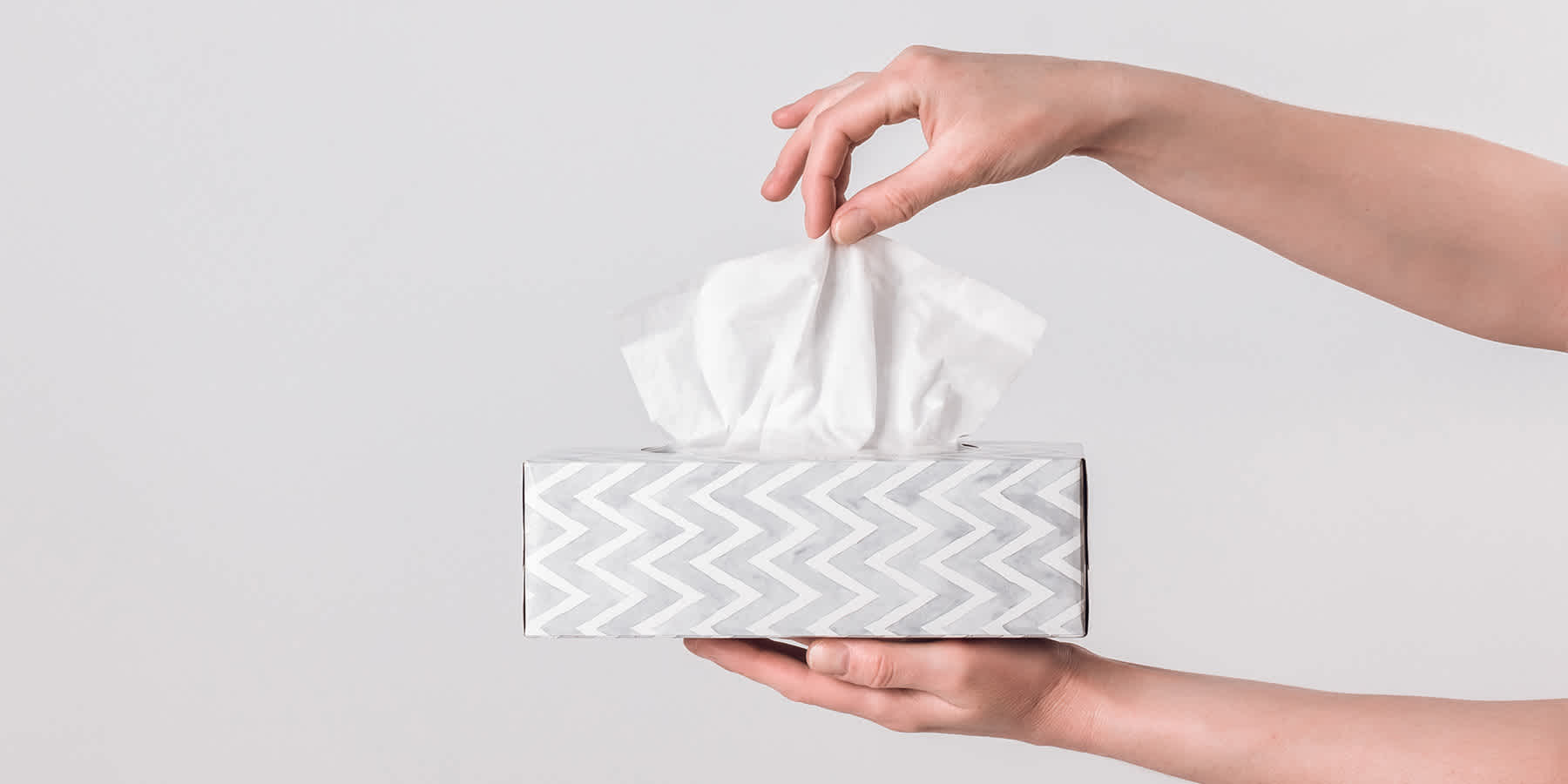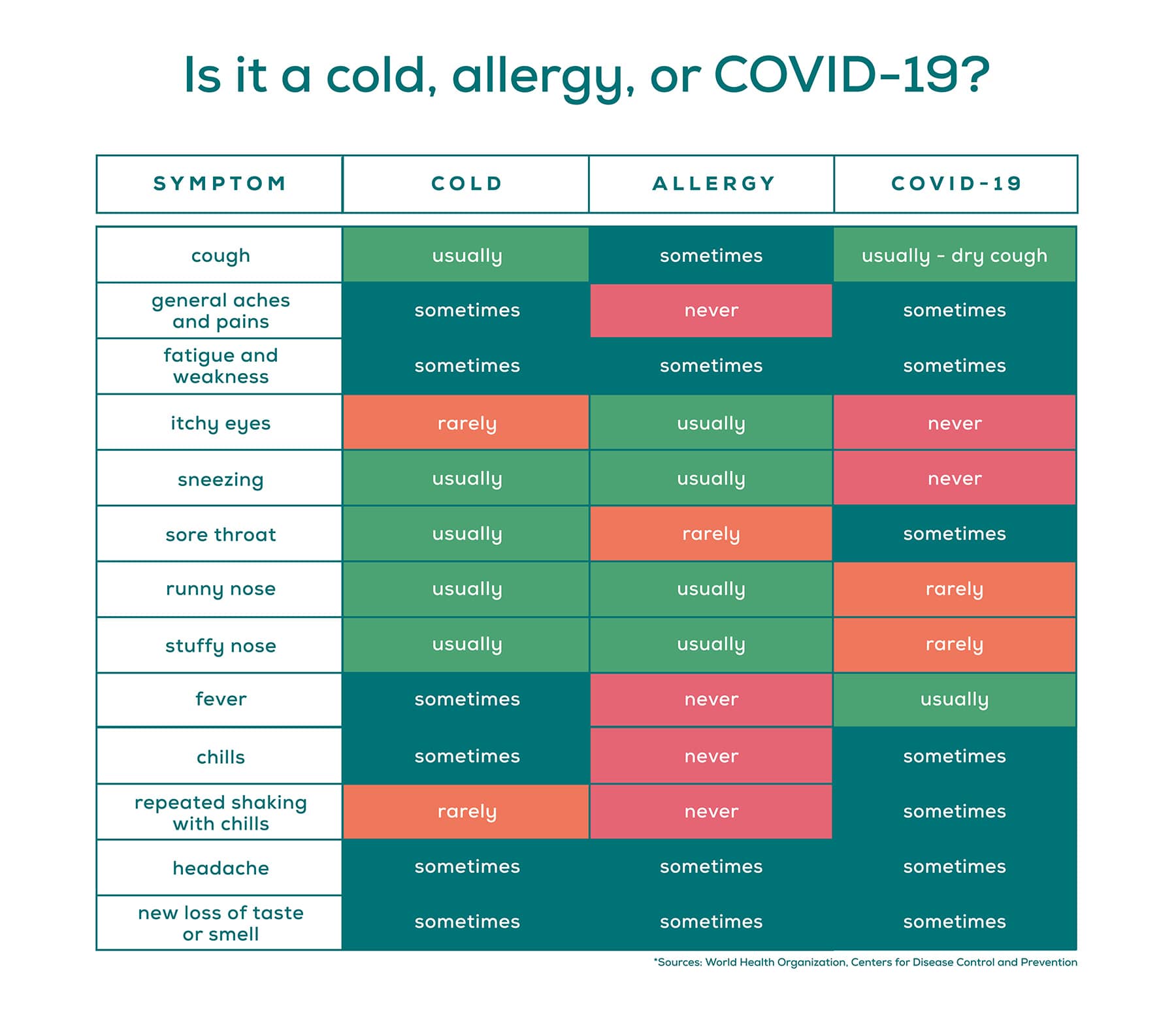
Is it a cold, allergies, or COVID-19?
Medically reviewed by Rosanna Sutherby, PharmD on March 25, 2020. To give you technically accurate, evidence-based information, content published on the Everlywell blog is reviewed by credentialed professionals with expertise in medical and bioscience fields.
When we're sneezing, coughing, and feeling run-down—we tend to ask ourselves the same question we ask every spring or fall season. Do I have a cold or allergies? But with COVID-19 spreading throughout the nation, it's not unreasonable to now add the virus to the list.
Of course, only a physician can provide you with a proper diagnosis, but it may be helpful to explore your symptoms before consulting with your physician. In this article, we'll shed some light on differences between key symptoms for these conditions, so you can feel more informed when making a telehealth appointment.
Fever
Let's start with a critical symptom differentiator: a fever. According to the Centers for Disease Control and Prevention (CDC), while symptoms at illness onset vary, 83-99% of people with COVID-19 will experience a fever. If you are not experiencing a fever, you may be more likely dealing with a cold or allergies.
Cough
This one is tricky. A cold, COVID-19, and allergies can all affect our respiratory system, so understanding which condition is the cause of your discomfort will help you prepare for the seasons ahead. The main difference is that COVID-19 has been reported as a dry cough, also known as non-productive cough, as it does not produce phlegm.
Additionally, if you are experiencing a fever and a cough, that would be a more concerning sign of a COVID-19 infection. A wet cough produces mucus and may cause you to wheeze. This may be more of an indicator of a cold.
Shortness of breath
Shortness of breath can sometimes feel like you can't catch your breath, or it's difficult to inhale. It's a feeling of breathlessness and a ubiquitous sign of COVID-19. You often do not experience shortness of breath with a cold or allergies, unless you're asthmatic or a cold has progressed to pneumonia.
Sneezing
Sneezing is a prevalent symptom of allergies and the common cold. But they're not typical of COVID-19. If you sneeze, it often only occurs when you're exposed to a specific allergen. With the Everlywell Indoor & Outdoor Allergy Test kit, you can check antibody reactivity levels to 40 different indoor and outdoor allergens—from the convenience of home. By identifying potential allergy triggers, you can take steps to reduce your exposure and relieve common symptoms like sneezing.
Cold, allergy, and COVID-19 symptoms: what's the difference?
The chart below breaks down the key differences between symptoms of all three conditions.

How long have you been feeling unwell?
It's also important to recognize the length of time in which you've been feeling unwell. Colds could last three to 10 days, but some may last longer. Allergies tend to last as long as you're exposed to the allergen that's causing you discomfort. Do your symptoms tend to occur at certain points in the day? This is a good question to ask yourself to figure out if your symptoms are caused by allergies or a cold.
For example, if you notice that symptoms like congestion, headache, and sneezing occur when you go outside, allergies are more likely at fault instead of a cold. Some of the most common allergy triggers to be aware of include dust mites, pet dander, and pollen. Also, while year-round allergies are possible, many people experience an increase in symptoms during peak allergy season (typically spring, summer, and/or fall).
COVID-19 symptoms can appear anywhere between 2-14 days after exposure to the virus. According to the World Health Organization (WHO), on average, it takes 5–6 days from when someone is infected with the virus for symptoms to show.
If you believe you are experiencing COVID-19 symptoms or have been in contact with someone diagnosed with the virus, contact your physician right away to tell them about your symptoms before any appointment. And if you’re experiencing emergency COVID-19 symptoms such as, confusion, trouble breathing, chest pain or blue lips or face, seek care immediately. You can also find out whether you are infected with SARS-CoV-2 in the comfort and safety of your home with the Everlywell at-home COVID-19 test collection kit.
With the Everlywell Indoor & Outdoor Allergy Test, you can check antibody reactivity levels to 40 different indoor and outdoor allergens—from the convenience of home. By identifying potential allergy triggers, you can take steps to reduce your exposure and relieve symptoms.
Related content
We’re exposing indoor and outdoor allergies
Indoor vs. outdoor allergies: top tips for managing symptoms
Fact or fiction? Top 5 truths about allergies you need to know
Pet allergies: causes, symptoms, and remedies
5 ways to prevent dust mite allergies
How to welcome the spring season without the allergy attacks
Indoor and outdoor airborne allergens: what are they and how to prevent them
References
Cold or allergy: Which is it? Mayo Clinic. URL. Published 2020. Accessed March 26, 2020.